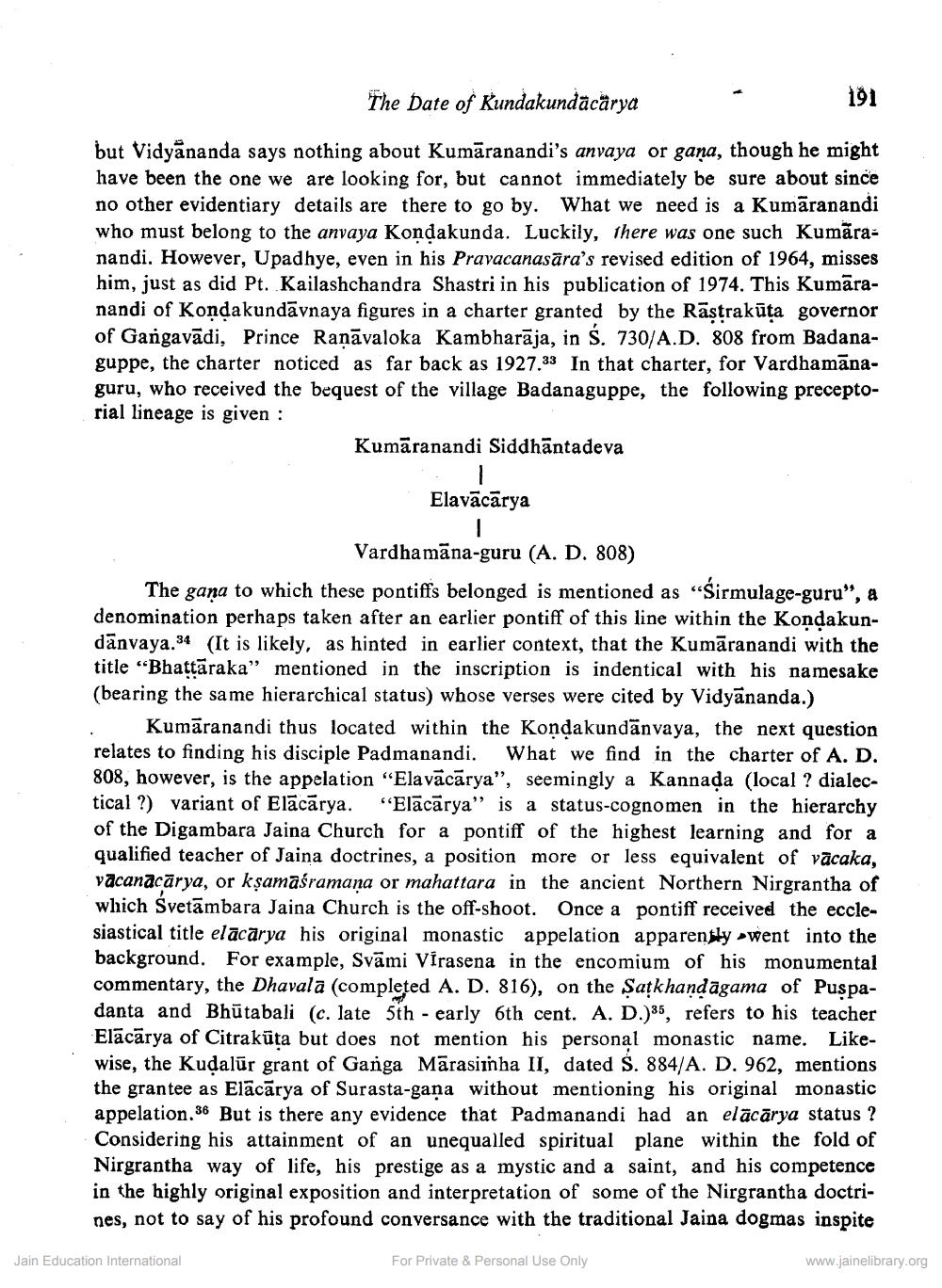Book Title: Date of Kundakundacharya Author(s): M A Dhaky Publisher: Z_Aspect_of_Jainology_Part_3_Pundit_Dalsukh_Malvaniya_012017.pdf View full book textPage 5
________________ The Date of Kundakundācārya 191 but Vidyananda says nothing about Kumāranandi's anvaya or gana, though he might have been the one we are looking for, but cannot immediately be sure about since no other evidentiary details are there to go by. What we need is a Kumāranandi who must belong to the anvaya Kondakunda. Luckily, there was one such Kumāranandi. However, Upadhye, even in his Pravacanasāra's revised edition of 1964, misses him, just as did Pt. Kailashchandra Shastri in his publication of 1974. This Kumāranandi of Kondakundāvnaya figures in a charter granted by the Rästrakūta governor of Gangavādi, Prince Ranāvaloka Kambharāja, in S. 730/A.D. 808 from Badanaguppe, the charter noticed as far back as 1927.33 In that charter, for Vardhamānaguru, who received the bequest of the village Badanaguppe, the following preceptorial lineage is given : Kumāranandi Siddhāntadeva Elavācārya Vardhamāna-guru (A. D. 808) The gana to which these pontiffs belonged is mentioned as "Sirmulage-guru", a denomination perhaps taken after an earlier pontiff of this line within the Kondakundänvaya.34 (It is likely, as hinted in earlier context, that the Kumāranandi with the title "Bhattāraka" mentioned in the inscription is indentical with his namesake (bearing the same hierarchical status) whose verses were cited by Vidyānanda.) : Kumāranandi thus located within the Kondakundänvaya, the next question relates to finding his disciple Padmanandi. What we find in the charter of A. D. 808, however, is the appelation "Elavācārya", seemingly a Kannada (local ? dialectical ?) variant of Elācārya. "Elācārya" is a status-cognomen in the hierarchy of the Digambara Jaina Church for a pontiff of the highest learning and for a qualified teacher of Jaina doctrines, a position more or less equivalent of vācaka, vacanācārya, or kşamaśramana or mahattara in the ancient Northern Nirgrantha of which Svetāmbara Jaina Church is the off-shoot. Once a pontiff received the ecclesiastical title elācārya his original monastic appelation apparently went into the background. For example, Svāmi Virasena in the encomium of his monumental commentary, the Dhavala (completed A. D. 816), on the Satkhand agama of Puspadanta and Bhūtabali (c. late 5th - early 6th cent. A. D.)35, refers to his teacher Elācārya of Citrakūta but does not mention his personal monastic name. Likewise, the Kudalūr grant of Ganga Mārasiinha II, dated S. 884/A. D. 962, mentions the grantee as Elācārya of Surasta-gana without mentioning his original monastic appelation.36 But is there any evidence that Padmanandi had an elācārya status? Considering his attainment of an unequalled spiritual plane within the fold of Nirgrantha way of life, his prestige as a mystic and a saint, and his competence in the highly original exposition and interpretation of some of the Nirgrantha doctrines, not to say of his profound conversance with the traditional Jaina dogmas inspite Jain Education International For Private & Personal Use Only www.jainelibrary.orgPage Navigation
1 ... 3 4 5 6 7 8 9 10 11 12 13 14 15 16 17 18 19 20
